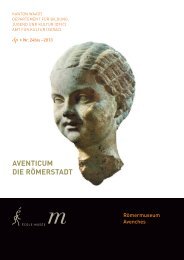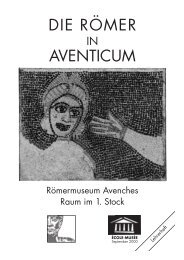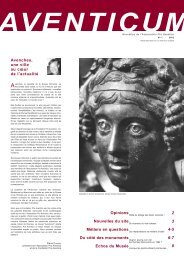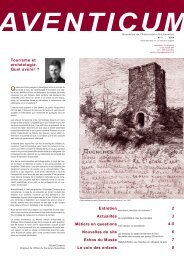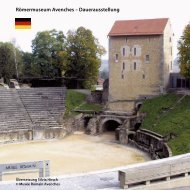Avenches – Roman Museum – Permanent Exhibition
Avenches – Roman Museum – Permanent Exhibition
Avenches – Roman Museum – Permanent Exhibition
Create successful ePaper yourself
Turn your PDF publications into a flip-book with our unique Google optimized e-Paper software.
Second Floor Protective Gods of the Household<br />
It is difficult to estimate the number of people that would have lived in one<br />
house. It can be assumed that there would have been at least three generations:<br />
grandparents, parents and children, but also aunts and uncles, and, of course, all the<br />
servants.<br />
The Interior Decoration of a Room Situated on insula 10 East<br />
Reconstruction of the “White Room” (1)<br />
The walls inside most houses in Aventicum were decorated with either simple or rich<br />
ornaments depending on the function of the rooms and the wealth of the owner.<br />
These murals were found in a room heated by a hypocaust (floor heating). The backs<br />
of the fragments still show traces of the heating system in the walls and the framework of<br />
the vaulted ceiling.<br />
Since limited space in the museum does not permit the reconstruction of the room in<br />
its original height of 3.75 m, the bottom 1.6 m of the wall are not represented.<br />
The floating couple Amor and Psyche are depicted above a window in the back<br />
wall of the room. The long walls are decorated with female heads representing the four<br />
seasons <strong>–</strong> here spring and summer <strong>–</strong> framing a still life consisting of pears and an apple,<br />
which are attributes of the summer. Further still lifes were painted on the vaulted ceiling:<br />
a lemon on the left, a pomegranate and figs on the right, and between them a woman<br />
holding a torch, placed in the centre of a veil draped over a bed of roses.<br />
The style, the artistic technique and the archaeological context date this room, which<br />
was part of a house owned by a wealthy person, to the first third of the 3rd century AD.<br />
Model of the Murals in the “White Room”<br />
The model illustrates how fresco wall paintings were made in a workshop of the<br />
3 rd century AD: A worker is covering the wall with the first layers of mortar, a painter is<br />
applying the colours while the master is discussing the design. The painting is applied on<br />
the topmost and finest layer of mortar, while it is still wet.<br />
This room would have been heated by a hypocaust, a system heating the floor and<br />
the walls. The hot air emanating from a furnace (praefurnium) circulated between two<br />
layers of tile flooring. The lower layer rested on pillars (pilae) between 50 and 70 cm in<br />
height and set at original intervals. The hot air could also move up through the walls in<br />
vertical flue tiles (tubuli) fitted into the walls.<br />
Scale 1:10.<br />
Protective Gods of the Household<br />
The six bronze statuettes (2) belong to a small domestic altar (lararium) from<br />
insula 27. Such altars were usually placed either in the atrium (inner courtyard), in<br />
the peristyle garden or sometimes in the kitchen.<br />
These statuettes of <strong>Roman</strong> deities represent (from top to bottom and left to right)<br />
Fortuna, Minerva, Juno, another Minerva, Mercury and Lar to ensure the protection<br />
of the family members during their daily routine. This group was assembled<br />
between the 1 st and 2 nd centuries AD.<br />
1<br />
2<br />
54<br />
Second Floor



